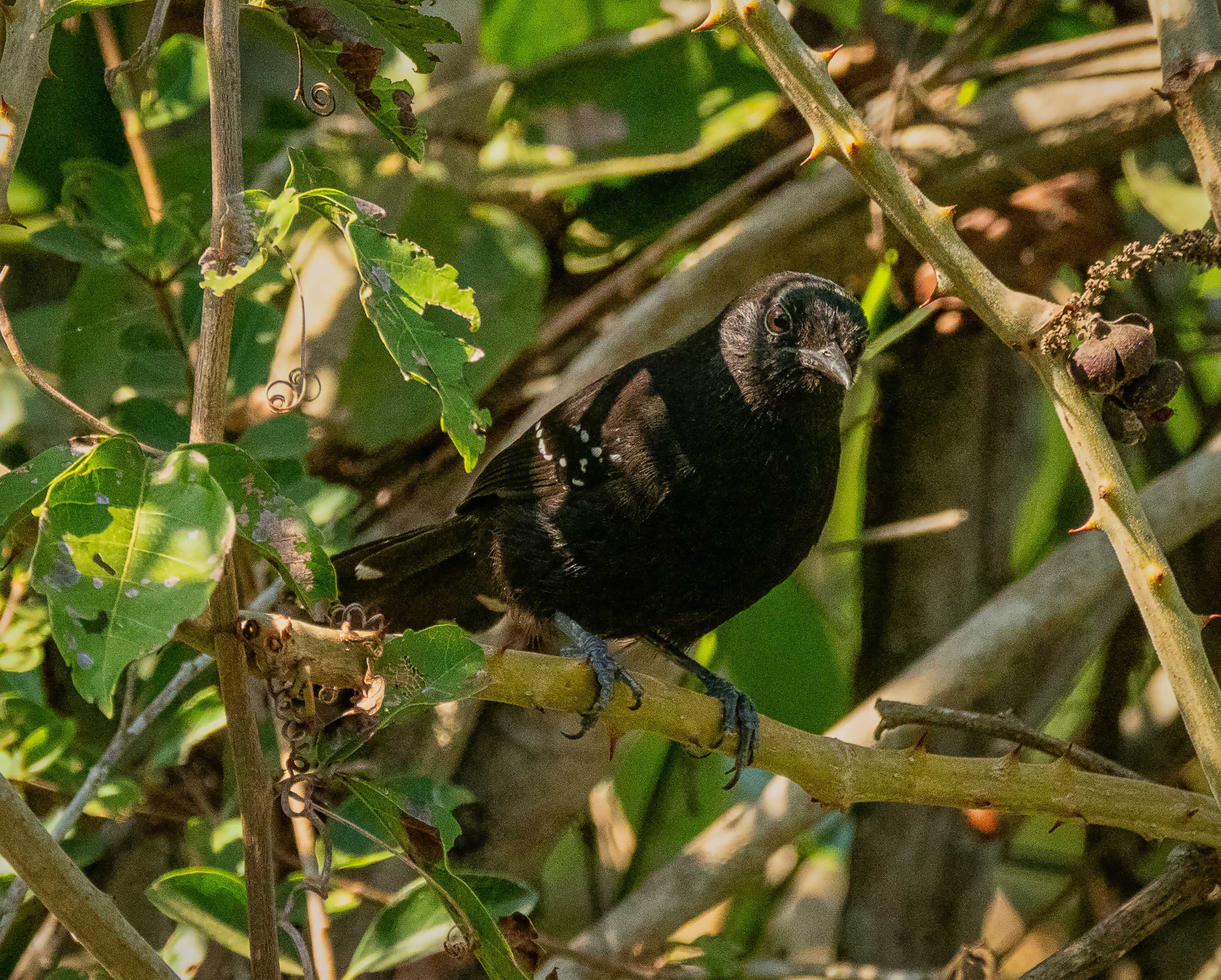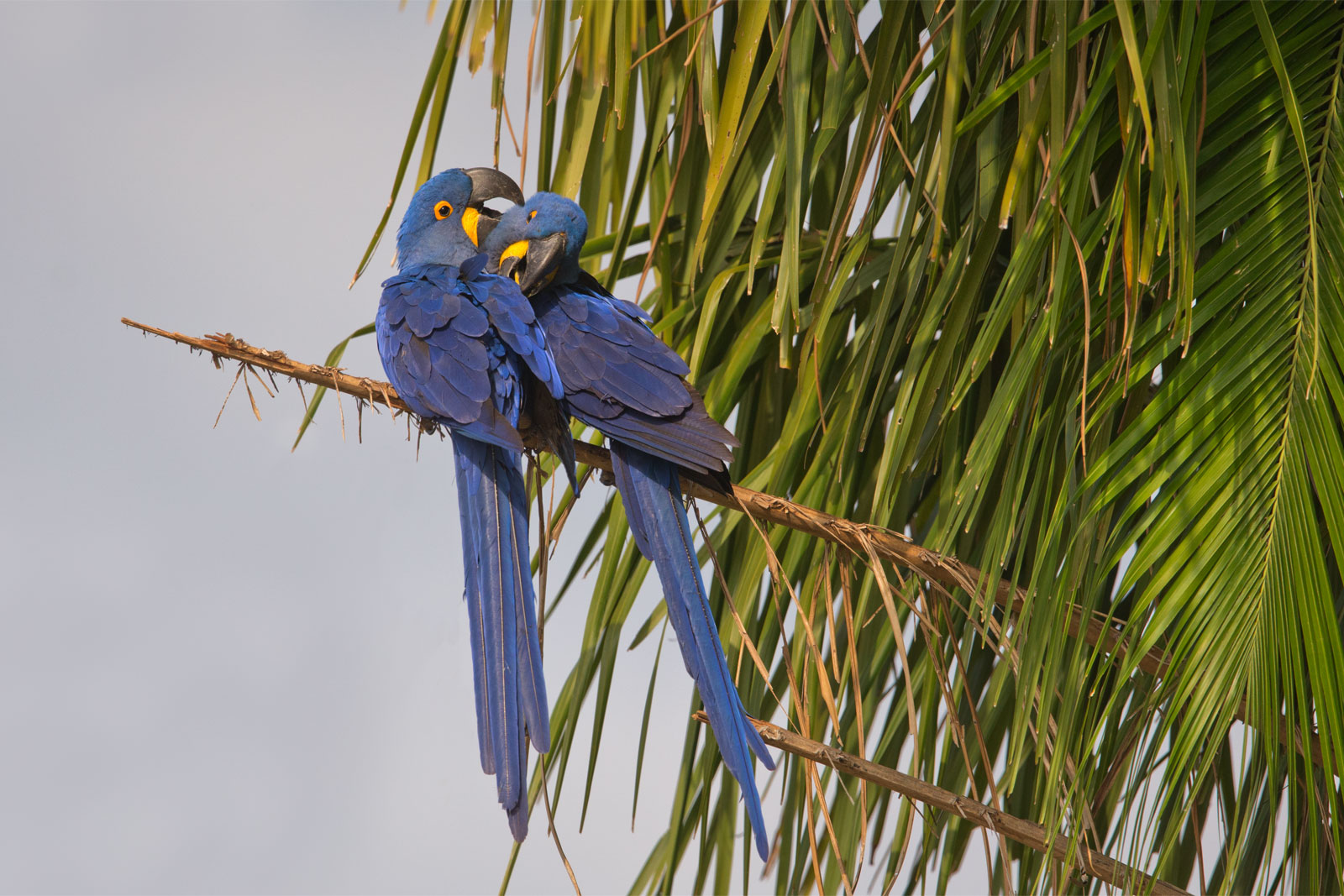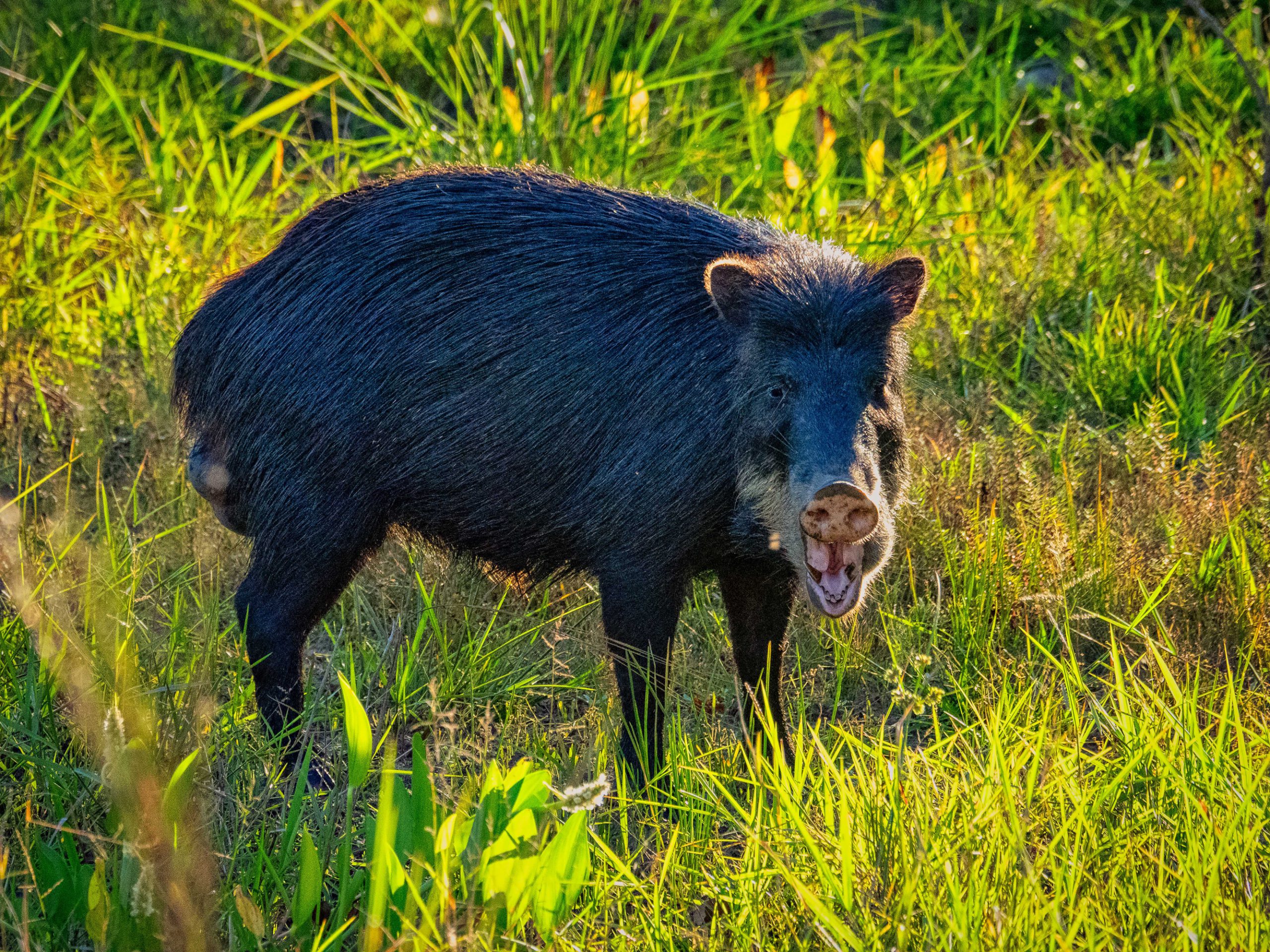Travel to São Paulo, Brazil
Aug 9
Arrive in São Paulo for an overnight and welcome dinner before your group flight to Cuiabá the following morning.
 Private Trip Available
Private Trip Available Join Our Waitlist Today!
Be the first to know if spots become available for this sold-out trip. By signing up, you’ll also receive notifications about our next exciting adventure to this destination when it’s organized and posted on our website. Secure your place in line for the adventure of a lifetime with Cheesemans’ Ecology Safaris!
Explore the vast Pantanal for South America’s Big Five – jaguar, giant anteater, giant otter, ocelot, and South American tapir. Travel via boat, private bus, and safari vehicles through regions where marshes, lakes, and streams provide a diverse ecosystem that fosters superb encounters with these awe-inspiring mammals plus many beautiful birds, like the hyacinth macaw. Journey down the famous Transpantaneira Highway in the northern Pantanal to Porto Jofre where cruises on the Cuiabá River afford numerous opportunities to see jaguars, giant otters, and other wildlife not easily seen by land. While in the southern Pantanal, stay at Caiman Lodge, a top wildlife destination, and a sure bet for giant anteaters and ocelots. Join biologists in the field to learn about this region’s wildlife research and conservation efforts. Don’t miss this spectacularly beautiful UNESCO World Heritage Site and biosphere reserve!
⭐⭐⭐⭐⭐ “The Pantanal is an amazing area! We were able to view all of the big 5–jaguar, ocelot, tapir, giant anteater, giant otter—many of them multiple times. We saw other wonderful animals and hundreds of beautiful birds. Our guide, was the best guide I’ve ever had on a trip!” – Nancy Frank |
Itinerary Updated: May 2024

| Date | Description | Lodge | Meals |
|---|---|---|---|
| Aug 9 | Arrive in São Paulo, Brazil. | Hotel Panamby Guarulhos, Guarulhos | D |
| Aug 10 | Group flight to Cuiabá in the morning, then drive the Transpantaneira Highway to Araras. | Araras Eco Lodge, Northern Pantanal | B, D |
| Aug 11 | Explore Araras. | Araras Eco Lodge, Northern Pantanal | B, L, D |
| Aug 12 | Morning game drive at Araras, then drive and sightsee south to Porto Jofre. | Hotel Pantanal Norte, Porto Jofre | B, L, D |
| Aug 13-16 | Boat trips on the Cuiabá River to find jaguar, giant otters, monkeys, and birds. | Hotel Pantanal Norte, Porto Jofre | B, L, D |
| Aug 17 | Morning boat ride, then fly from Porto Jofre to Pousada Aguapé. | Pousada Aguapé, Southern Pantanal | B, L, D |
| Aug 18 | Learn about local issues and wildlife at Pousada Aguapé with conservation researchers. | Pousada Aguapé, Southern Pantanal | B, L, D |
| Aug 19 | More research at Pousada Aguapé; drive to Fazenda San Francisco in the afternoon. | Fazenda San Francisco, Southern Pantanal | B, L, D |
| Aug 20 | Search for giant anteater, ocelot, and other wildlife at Fazenda San Francisco. | Fazenda San Francisco, Southern Pantanal | B, L, D |
| Aug 21 | Search for wildlife in the morning, then travel to Caiman Lodge. | Caiman Lodge, Southern Pantanal | B, L, D |
| Aug 22-23 | Look for giant anteaters and other wildlife around Caiman Lodge. | Caiman Lodge, Southern Pantanal | B, L, D |
| Aug 24 | Morning game drive at Caiman Lodge, then travel to Campo Grande. | Hotel Deville Prime, Campo Grande | B, L, D |
| Aug 25 | Fly from Campo Grande to São Paulo and then homeward. | B | |
| Aug 26 | Arrive home. |
Rafael studied Environmental Management, specializing in Tourism, the Environment, and Social Responsibility. He began his work as a naturalist guide in 2013 throughout the Amazon and Pantanal, later becoming the head of guides for the Pantanal’s Caiman Lodge. He enjoys sharing his knowledge and passion for nature and wildlife with travelers while also integrating the local communities and the importance of respecting the environment.
Arrive in São Paulo for an overnight and welcome dinner before your group flight to Cuiabá the following morning.

Transfer to the São Paulo Airport for the mid-morning group flight to Cuiabá, located in the northern part of the state of Mato Grosso. Upon arrival, drive across 56mi of the Cerrado region (Brazilian savanna) to the town of Poconé, and then drive 26mi south to the entrance of the Transpantaneira Highway – a truly extraordinary gravel road traversing some 93mi of the Pantanal. You will continue south down the Transpantaneira to Araras.
Explore the grounds of the Araras Eco Lodge, which include 7,413 hectares of wetlands, forest, and savannah. You can find birds, such as the cinereous-breasted spinetails and Mato Grosso antbirds, in the woodlands around the lodge and along an elevated boardwalk. The Araras property extends east of the Transpantaneira into the dry grasslands where you have a great chance to view both lesser and giant anteaters. After dinner, you will go on a night drive, the best time to encounter tamandua (also known as the lesser anteater) and perhaps a South American tapir.

© Cheesemans’ Ecology Safaris
After an early morning safari at Araras, you’ll journey south down the Transpantaneira Highway to the Cuiabá River in Porto Jofre, making stops along the way. Water lingers alongside the Transpantaneira, concentrating a wide variety of wildlife. You'll stop at some excellent places to stretch your legs and take photographic opportunities.

The best chances to spot jaguar are on the Rio Cuiabá. The jaguars in this region are protected and have become accustomed to boats full of photographers pointing lenses at them. You’ll ride in boats that can quickly reach the various tributaries of the Rio Cuiabá where the cats may be lounging or hunting.
You'll enjoy morning and late afternoon private boat trips when the sun isn’t directly overhead. Besides the beautifully colored birds, keep an eye out for mammals, including black-striped tufted capuchins, the crab-eating fox, South American tapir, and the enigmatic ocelot. You may encounter the most noteworthy reptiles throughout the Pantanal, including hundreds of Yacaré caimans and some green iguanas, and if you are lucky, you may come across a rare yellow anaconda.
Start today with another morning boat trip. After lunch, take a charter flight to Pousada Aguapé, a remote working ranch with abundant opportunities for wildlife encounters.

With a base near Pousada Aguapé, the Peccary Project (Projeto Queixada) has partnered with the surrounding rural community to protect the Pantanal’s biodiversity. The ranch’s sustainable practices have contributed to the high wildlife diversity you will see as you tour the area. Local researchers from the Peccary Project will show you their conservation work in the region, including their work on the critically endangered white-lipped peccary.
Continue your search for more magnificent birds and charismatic mammals of the southern Pantanal region. In the afternoon, you will travel to nearby Fazenda San Francisco.
Here, you’ll have your best chances of finding giant anteater and ocelot on game drives and during nightspotting, and sometimes you may even see jaguar, maned wolf, and South American tapir. Fazenda San Francisco has extensive native forest, wetlands, and grasslands, but it’s also a working ranch with cattle pastures and vast rice fields. The owner and staff work very hard to preserve wildlife, particularly to protect the rare mammals. Blue-and-yellow macaws, parrots, parakeets, toucans, and toucanets are plentiful right around the lodge and are extremely habituated. You’ll game drive in the evening and at dawn for the best action, and enjoy breaks on the lodge grounds during the warm part of the day.
Take another early morning game drive before heading to the famous Caiman Lodge.

Caiman Lodge, which is best of the best of nature lodges in South America, has charming accommodations, a very experienced friendly staff, delicious food, very high-quality service, and best of all, amazing wildlife! This is our favorite location in all of the Pantanal. You’ll begin your explorations in the beautiful surroundings for birds and other wildlife. You’ll also enjoy night drives to spot nocturnal wildlife in action. You have good chances for locating jaguars, but the overall wildlife experience while immersed in beautiful native habitat is the highlight here at Caiman, named for the plethora of Yacaré caimans, who peer with their gleaming, beady eyes at night. With luck, you will encounter mother giant anteaters with young on their backs, gray brocket deer, pampas deer, two species of armadillos, tapeti (Brazilian rabbit), and crab-eating raccoon. Elusive wildlife is very challenging to photograph, so you’ll spend ample time in nature to be sure to get some great images.
Spend the last morning photographing the resident macaws and other species. If the light is not ideal, or the group prefers, you can take a drive to the river for some action there!
You’ll transfer as a group to the Campo Grande Airport for your flight to São Paulo and then homeward.
| Type | Cost Per Person |
|---|---|
| Trip Cost, double occupancy | $14,900 |
| Single Supplement | Contact Us |
Costs are per person, double occupancy, not including airfare (except for three internal flights), singles extra. See Included and Not Included sections for more details.
If you are a single traveler, we will find a roommate for you, but if we cannot find you a roommate, we may charge you a single supplement. Single rooms cost extra and are subject to availability.
| Payment | Due Date | Amount Per Person |
|---|---|---|
| Deposit | Due now to reserve your space | $500 |
| Final | March 2, 2025 | Remaining balance |
Payments are due based on the schedule above. All reservations require a deposit to confirm reservation of your space.
Until the Final Payment due date, deposits are refundable except for a cancellation fee of $150 per person, which can be applied toward another trip if reserved within six months of the cancelled trip’s departure date. Cancellations are non-transferrable. No refunds are given after the Final Payment due date.
The Pantanal can be very hot, from 90 to 100+°F (32 to 38+°C), especially during midday and afternoons. The occasional cold snap may blow through, dropping the temperature to the 60s°F (~15 to 20°C), so layer clothes to manage these changing conditions!
Most wildlife viewing is done from small boats and vehicles. Walks to search for wildlife are generally less than an hour over relatively flat trails or along gravel roads. Please contact us if you have any health concerns that may make this trip challenging.
Detailed logistical information is included in the Trip Planning Materials we will send you.
Flights you book
Flights we book
While the Amazon is much more famous, the Pantanal is the best place to see Brazil’s wildlife as it has much greater biodiversity and a higher density of that biodiversity. The Pantanal is the world’s largest wetland and therefore attracts many large mammals (the Big Five), smaller mammals such as monkeys and capybaras, and many beautiful birds.
We visit in July through September during the dry season when wildlife tends to concentrate around the ponds left after the wet season’s floods. Fields are now dry, enabling us to hike and drive safari-style through them to look for wildlife. It is also warmer during these months and the coolness of the river entices jaguars to the riverbanks to cool off. July through September are also good months to see plentiful birds.
Our goal is to see the Big Five, but we cannot guarantee that we will see them all as wildlife is wild and unpredictable! But to best meet our goal, we spend the maximum time in nature to greatly increase our chance of seeing the Big Five and lots more.
During days near the Cuiabá and other rivers, we spend a lot of time in boats as it is the best way to see jaguar and other wildlife. Wildlife is accustomed to tourist boats and feel safe around them, generally allowing us to approach to watch and photograph them.
The rivers in this region are calm and we have never had problems with anyone getting seasick.
All lodges have private baths and air conditioning.
Don’t let a fear of motion sickness keep you away! Even those who have experienced motion sickness reported that the incredible wildlife and overall experience were well worth the temporary discomfort. If you are susceptible to motion sickness from bumpy roads, small boat rides, or are concerned that you might be, please come prepared! The key to avoiding motion sickness is to act before you experience nausea. Do your own research and consult your doctor before taking any medications. A good night of sleep, eating well, limiting alcohol, and using your favorite seasickness remedy is sufficient for most travelers. Find more information on our Coping with Seasickness webpage (this information is applicable to any form of motion sickness) and contact us if you have any questions.
You will travel by air-conditioned private bus, boat, and commercial air. Some remote roads in the Pantanal are unpaved, dusty, and bumpy. Some of the drives between regions are long, between one and five hours, but most of these are on paved, modern roads. The boats are comfortable (the seats have backrests) and are easy to get in and out of. Although the boats have limited space, you have room for your daypack and camera gear near your feet and on your lap.
Our company ethos has always regarded conservation as inseparable from responsible tourism. We struggle with the dilemma that traveling worldwide expends climate-changing carbon. However, we wholeheartedly believe that traveling with us will cultivate your passion for conserving our beautiful world while stimulating each destination’s local economy. We encourage you to explore the various ways in which Cheesemans’ operates within this context:
Read our current Terms and Conditions.
 Rafael Andrade
Rafael Andrade